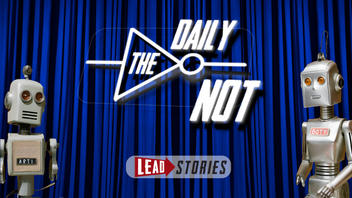
If you have been following Lead Stories on TikTok, Instagram, WhatsApp or YouTube you may have already seen them, but now we're making it official. Lead Stories is proud to present "The Daily NOT," a show presented by robot hosts Artie Ficial and Botty McBotface. The Daily NOT is your daily video overview of all fact checks done by Lead Stories that day.
For the past few months and through the same channels (and Threads and X) we've been making all our individual fact checks available as short videos summarizing the claim, the conclusion and the reason. For the full details and sources you can of course always come to the Lead Stories website where you will find the full articles the videos are based on.
Note that on YouTube there is a dedicated playlist if you want to subscribe to The Daily NOT only.
How does it work?
Longtime readers of our site know that all our fact checks follow the same format, as explained in detail on our "How We Work" page. Specifically about the headline and first paragraph the page says this:
- A headline that starts with "Fact Check:" and which immediately contains the conclusion of the fact check ("X Did NOT Do Y").
- Introductory paragraph that starts with the claim as a question, directly followed by the answer and a two or three sentence summary of the reason for that answer. ("Did X Do Y? No, that's not true. Video shows Y was at a different place when X happened and local police confirmed this.")
Our stories also always come with a screenshot of the page, video, post or image making the claim, overlaid with a short caption sticker that explains what the problem is with the claim.
These elements are very easy to turn into a video and through the magic of screenshots, ffmpeg, synthetic voices from Google, OpenAI's Whisper (for the subtitles), music, sound effects and some automated software tools, we can now turn any Lead Stories fact check into a short video at the press of a button. The entire process takes about a minute, which is way faster than recording and editing a video by hand each time. Here's an example of the result:
The videos come out in a format that is ready to be published to our various social media channels. We started working on this system in September 2023 and since then we've already been able to publish hundreds of fact check videos at virtually no extra cost. On some days we easily uploaded more than 10 videos without breaking a sweat.
The Daily NOT
But we took it one step further: At the end of each day all videos are turned into a mini-talk show with robot presenters Artie Ficial and Botty McBotface. The pictures of Artie and Botty were generated using Canva and the rest of the technology used to create the show is essentially the same as for the fact checking videos.
Because of the structure of the first paragraph of our fact checks it is also very easy to turn them into a dialogue:
- Question: Did thing happen?
- Answer: No, that's not true: Thing was a joke from a satire website.
- Reaction: Oh, I see!
- Details: The site in question has a disclaimer that reads ...
- Closing remark: Well, there you have it folks ...
The bold parts are already in the text so all we had to do was to come up with a way to get the other parts. The reactions were easy enough: Just pick from a random list, like humans do: mmh, OK, right, uhuh, I see ... For the closing remark we turned to ChatGPT and we found this works quite well.
We did have to work on refining the prompt with enough safeguards to prevent inappropriate jokes when the topic of the fact check involves tragic events, diseases, deaths, etc. And of course you can't use ChatGPT-generated text before it is vetted and corrected (if needed) by humans, but that still is far less work than writing it all by hand.
Add in a short intro section with a "teaser" sentence spoken by Botty and a "That's all folks" screen at the end, and you get:












